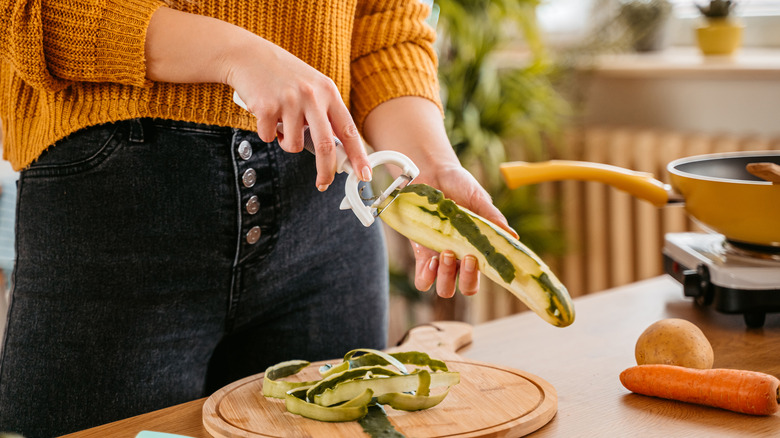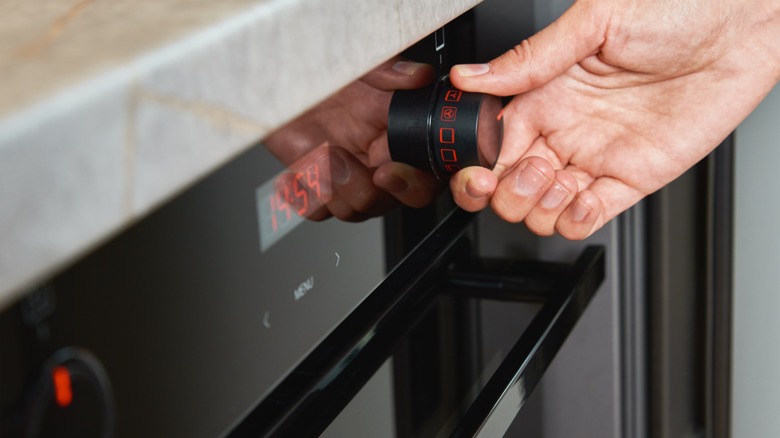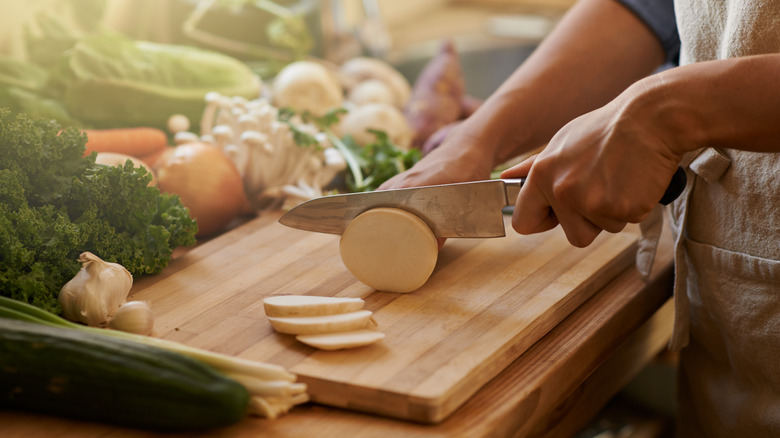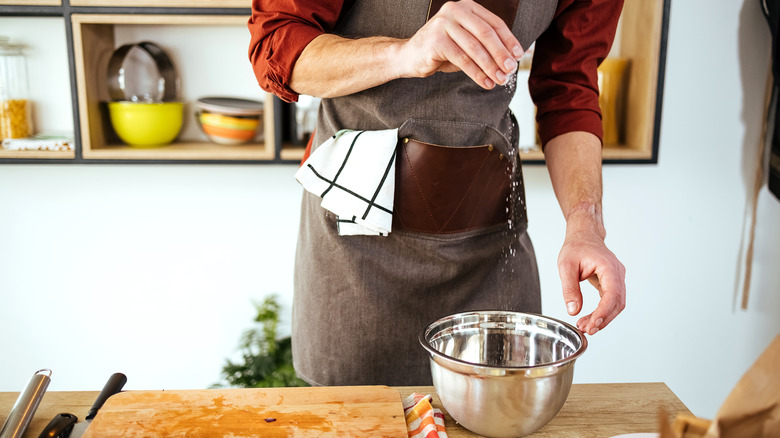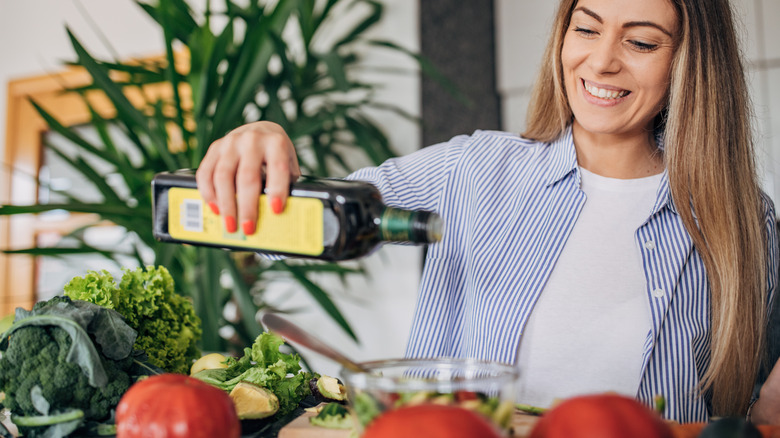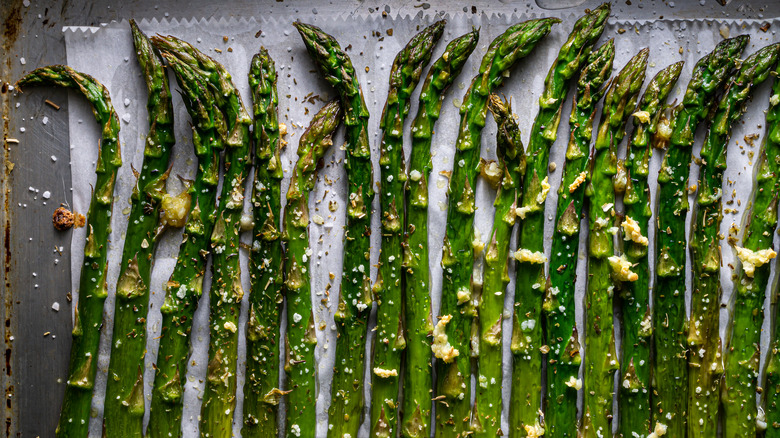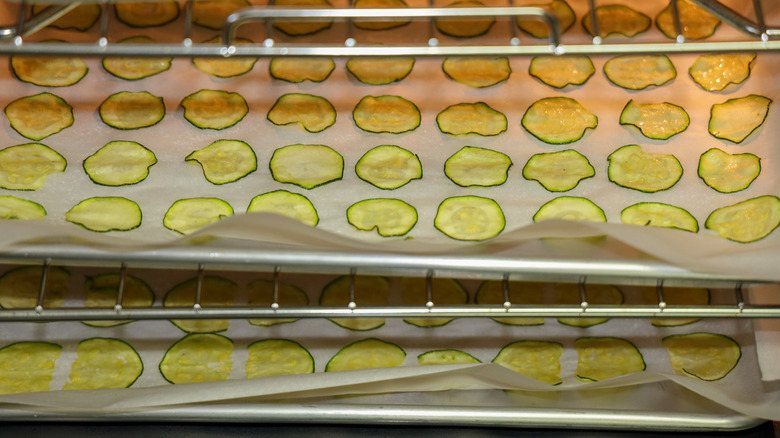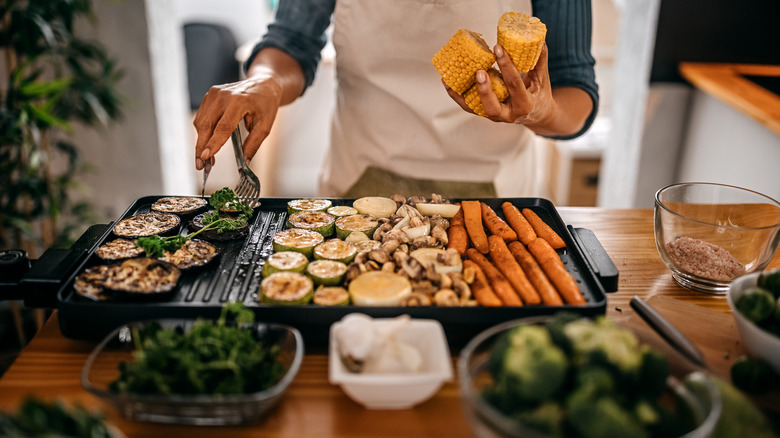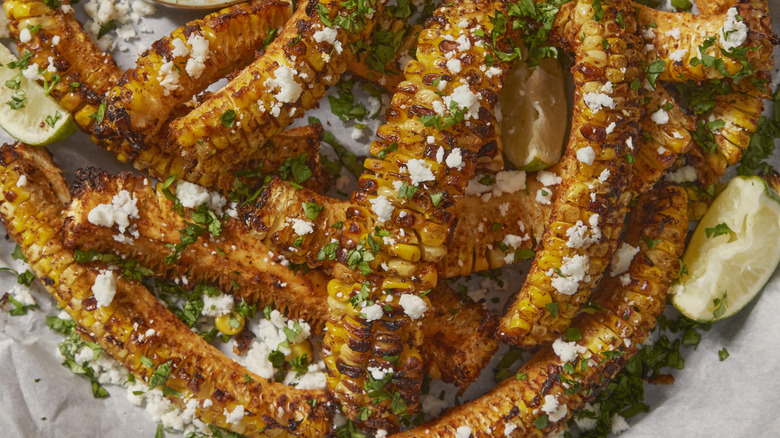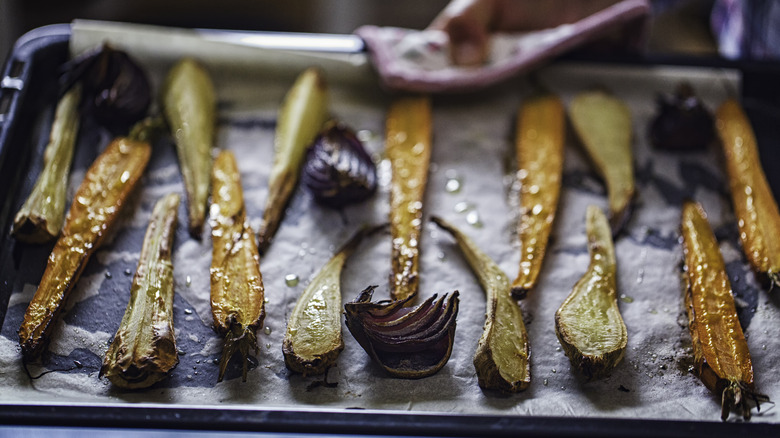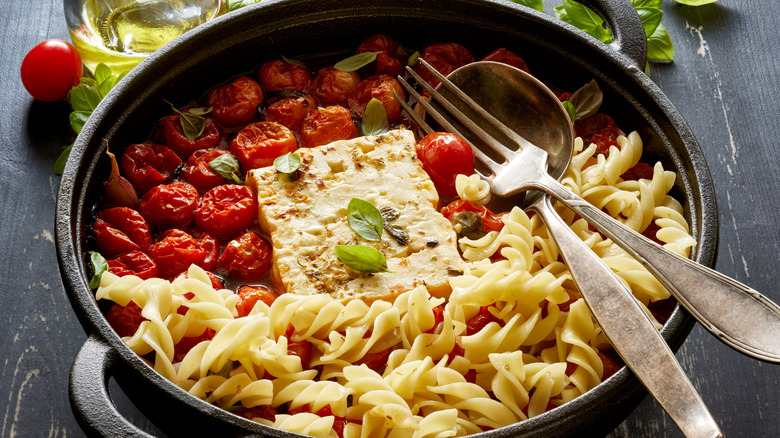Ina Garten's Best Hacks For Roasting Vegetables
From owning her own gourmet grocery store to authoring more than a dozen cookbooks, Ina Garten's experience speaks for itself. Of course, she is also the star of the famous Food Network cooking show "Barefoot Contessa," which has been on the air for 20 years. Considering Garten's impressive resume, it's no surprise following her advice leads to better-tasting food all around, and her tips for perfectly roasted vegetables are just one small example of why she is so revered.
Whether you're seeking to learn about the right temperature for roasting, proper preparation techniques, appropriate spacing on the baking tray, or suggestions on seasoning, Ina Garten has advice and tips to help. For example, did you know it's best to leave space between your veggies while they are roasting? Or that the type of olive oil you use can make a massive difference for the entire recipe? Either way, her best hacks for roasting vegetables are pretty much guaranteed to help you take your cooking skills to the next level. Give them a try to get evenly cooked, perfectly seasoned, flawlessly browned, crispy, delicious roasted veggies every time.
Start by washing and peeling veggies
The first step in vegetable preparation involves washing them, regardless of how you plan to cook them. For most veggies, you can simply rinse them under the faucet, give them a gentle scrub, and then set them aside to dry. However, some veggies, like cauliflower, require a more thorough cleaning with salt and vinegar.
Once your vegetables are clean and dry, Ina Garten recommends peeling most root vegetables. While this probably doesn't come as a surprise, it is a vital step and shouldn't be skipped if you want to achieve tender roasted veggies. Otherwise, the exterior of root vegetables like parsnips, sweet potatoes, beets, and butternut squash will become tough while roasting. In Garten's Roasted Asparagus recipe, she also recommends peeling asparagus. While this isn't common, she notes it can reduce the tough texture that often occurs due to the skin.
Garten also stresses the importance of using a sharp vegetable peeler not only to avoid cutting yourself but also to help keep vegetables intact. According to a 2020 interview in Food & Wine, she even suggests tossing out and replacing your vegetable peeler once a year to prevent it from rusting and becoming dull. Thankfully, they are pretty cheap, so purchasing a new peeler is easy and accessible.
Roast veggies between 375 F and 425 F
For the most part, Garten recommends roasting vegetables at high temperatures. While the exact temperature varies slightly from one recipe to the next, her various recipes for roasting veggies call for anywhere from 375 F to 425 F. In her Roasted Winter Vegetables recipe with carrots, parsnips, sweet potatoes, and butternut squash, Garten recommends setting the oven to 425 F. For smaller veggies like whole baby peppers and broccolini, 400 F should suffice. Or, for softer veggies like zucchini, onion, and sliced bell peppers, Garten recommends roasting at 375 F, as is seen in her Roasted Summer Vegetables recipe.
One of the exceptions to Garten's high-temperature roasting strategy is found in her recipe for Emily's English Roasted Potatoes. Sure, the recipe starts off with a temperature of 425 F, but once the oil in the pan is hot, she drops the temperature to 350 F before adding the potatoes. This is most likely because the potatoes are blanched, so they get a chance to soften before roasting.
Don't cut vegetables too small
In several of Ina Garten's recipes that involve roasting veggies, she stresses the importance of keeping your sliced veggies somewhat on the larger side. When you roast vegetables, they shrink in size. It may not be a huge amount, but it happens nonetheless, and you want to keep your roasted veggies at a hearty size so they don't get swallowed up by the rest of your meal. This is particularly true with water-packed produce, like zucchini, because it shrinks a considerable amount during roasting.
Garten recommends cutting zucchini slices ¾ inch thick in her Roasted Summer Vegetables recipe, and while she admits this may seem large, they will shrink down to a more normal size while roasting. In the same recipe, Garten suggests cutting onion slices into ¼ inch rounds and slicing bell peppers into 1½-inch wide slices.
In her Roasted Winter Vegetables recipe, Garten recommends cutting the root vegetables in 1 to 1¼-inch cubes. Again, she notes that you should avoid cutting them too small because they will reduce in size while cooking. When it comes to roasting baby peppers, Garten says you can actually leave them whole, stems and all, as is seen in her Balsamic Roasted Baby Peppers recipe.
Generously season veggies with salt and freshly ground pepper before baking
As with any type of cooking, you don't want to skip adding salt and pepper when roasting vegetables. In fact, Garten likes to season roasted vegetables generously to get an even coating on all of the veggies before baking. If, for some reason, you forget this crucial step, your vegetables will undoubtedly wind up bland and lacking flavor. Thanks to salt drawing out moisture, certain vegetables may even become slightly soggy while roasting if you forget to add it beforehand.
In many of Garten's recipes, she calls for Kosher salt and freshly ground pepper, most likely because of their rich flavor profile. While Kosher salt is traditionally used to extract excess moisture from meats, it does the same thing when applied to vegetables. As a result, Kosher salt is ideal when it comes to roasting veggies to the perfect crispy texture. Using pre-ground pepper is always a mistake, regardless of the recipe. If you've ever compared pre-ground and freshly ground pepper, the difference is drastic. Freshly ground pepper has a bolder taste and spiciness that stands out in food. Whereas pre-ground pepper rapidly loses potency and flavor once ground, so it easily gets overshadowed by other spices.
Toss well in good olive oil
Salt, pepper, and olive oil are standard seasonings that bring out the flavor and help veggies crisp up nicely when roasting — particularly oil. Olive oil also prevents your veggies from sticking to the baking tray, so tossing your ingredients before cooking is a no-brainer. Garten wants you to toss your veggies well so that every piece gets a good flavor coating. In several of her recipes, she simply uses her hands. So feel free to skip the mixing bowl and get a little dirty. Of course, you should always wash your hands first.
Garten is also known for stressing the importance of using "good" extra virgin olive oil to enhance flavor. In the Ask Ina section of her Barefoot Contessa website, Garten explains what she means by good olive oil as "the best oil that your budget allows." She goes on to say that "it certainly doesn't need to be the most expensive." If you want to use the same high-quality olive oil she uses, look no further than Olio Santo. It comes from California, isn't heavy, and has a fruity, flavorful taste that she loves.
Spread veggies into a single layer on the pan
In all of Garten's roasted veggie recipes, she repeatedly discusses placing them on a baking tray in a single layer. Spreading out veggies so they don't overlap leads to more even cooking across the pan. It also ensures they crisp up nicely and reduces the amount of time needed for cooking, both of which are highly desirable. If you disregard this advice and layer your veggies even a little, some pieces will be crispy, others will be soft, and the rest will be somewhere in the middle.
Garten also notes that crowded veggies will steam rather than roast in her Roasted Summer Vegetables recipe, leading to a relatively mushy consistency. If you think about it, steaming your veggies is fine, but if you are looking forward to the crispy deliciousness of roasted veggies, they could leave you underwhelmed. Plus, if you are trying to roast veggies like a pro, it would be a shame if you went through all the steps just to wind up with expertly seasoned steamed vegetables.
Use a second baking sheet or roast in batches if you can't create space between veggies
As discussed above, a single layer of veggies is essential for roasting. Otherwise, you'll inadvertently steam them instead. To help prevent this, Garten recommends not only creating a single layer on your baking tray but also leaving space between each vegetable chunk or slice. The space doesn't have to be huge, especially since the veggies will shrink during roasting, but a small gap seriously improves roasting results. Leaving space between ingredients is the surefire way to achieve the desired crispy exterior found in properly roasted veggies.
If you are having trouble spreading all your veggies into a single layer with space between each piece, don't hesitate to use a second pan. Or, if you don't have space in the oven, roast your veggies in more than one batch. While this may seem excessive, Garten knows what she is talking about. Even if you only have a few more pieces to roast, using a second pan or making a second batch eliminates the chance of steaming them and pretty much guarantees a crispy exterior.
Toss the vegetables halfway through the roasting process
Alright, now that we have all the prep work and proper placement covered, there isn't much left to do except, of course, actually roast your veggies. However, after putting your vegetables in the oven, you will definitely want to flip or toss them halfway through the roasting process. Tossing them midway allows the veggies to brown evenly and ensures you reach the desired crispy texture in the end.
For Garten, tossing roasted veggies halfway through is a mandatory step. She mentions it in all of her roasted veggie recipes, even if it is just a quick note. In her Roasted Butternut Squash recipe, she says to toss the cubed pieces once while cooking with a large metal spatula so that they brown evenly. The same thing goes for her other recipes. If you accidentally skip this step, your vegetables will likely be crispy on one side and soft on the other. It may be best to set an alarm for the midway point to prevent accidentally forgetting. That way, you ensure you get even results all the way around.
Season vegetables with herbs and cheese
Of course, you'll want to season veggies before roasting them with salt, pepper, and oil, but Garten likes to take it a step further for enhanced flavor. In many of her recipes, she calls for additional herbs, spices, and even cheese to give your veggies a burst of drool-worthy flavor. Adding thyme sprigs to the pan while roasting is a common Garten enhancement, like with her Roasted Butternut Squash. She also uses cheese and parsley in several of her roasted vegetable recipes.
In Garten's Balsamic Roasted Baby Peppers recipe, she puts thyme sprigs on the pan while the peppers roast and then discards them once she takes them out of the oven. Then, she drizzles the peppers with balsamic before serving. In both her Roasted Broccolini & Cheddar and Parmesan-Roasted Broccoli recipes, she sprinkles cheese over the veggies near the end, puts them back in the oven for a couple of minutes, and finishes with a squeeze of lemon. Garten also likes to add minced parsley to the seasoning mix, as is seen in her Roasted Carrots and Emily's English Roasted Potatoes recipes.
Roast veggies until brown and crisp on the outside
One of the main differences with roasting veggies, instead of steaming or sauteing them, is that they wind up with a crispy exterior. When made correctly, roasted veggies also get a slightly brown coloring on the edges, which gives them added flavor and depth. To ensure you achieve the desired color and crispiness, Garten recommends roasting veggies for 20 to 40 minutes, depending on the type of veggies. For baby peppers, 20 minutes is perfect. For a blend of eggplant, onion, and bell pepper, 40 minutes is just right. Potatoes need a bit longer, like 45 minutes to an hour. Butternut squash takes 30 to 45 minutes, and broccolini only requires about 13 or 14 minutes.
If, for some reason, you aren't achieving the desired crispy, brown exterior with your roasted veggies, even with all of Ina Garten's amazing hacks, there's one more thing you can try. Instead of placing your veggies flat on a baking tray, spread them out on wire racks and then place the racks in the tray. Wire racks prevent mushy vegetables because elevating them off the pan allows the hot air to circulate around the vegetables the entire time they are roasting, essentially guaranteeing they come out crispy.
Scrape any leftover seasonings in the pan into the main dish
The final Ina Garten hack for roasting vegetables involves taking full advantage of all the yummy seasonings in the bottom of the pan after the roasting process is complete. To give the rest of the meal a boost, she likes to add all of the leftover seasonings from the baking tray to the other elements of the dish. Doing this helps tie the whole meal together by seamlessly blending the flavors used in the veggies.
Garten's leftover seasoning tip is perfect for pasta dishes, particularly if you top the pasta with your roasted veggies, as seen in her Orzo with Roasted Vegetables recipe. For this delicious meal, she roasts the veggies like normal and then adds them to the cooked orzo in a pasta bowl. Before finishing it with a zesty lemon dressing, she also scrapes all the veggie pan's oil, salt, and pepper into the mix. Not only does this eliminate waste, but it also enhances flavor in a super-efficient manner. In addition to pasta creations, this method works exceptionally well with meat dishes, rice bowls, and more.


